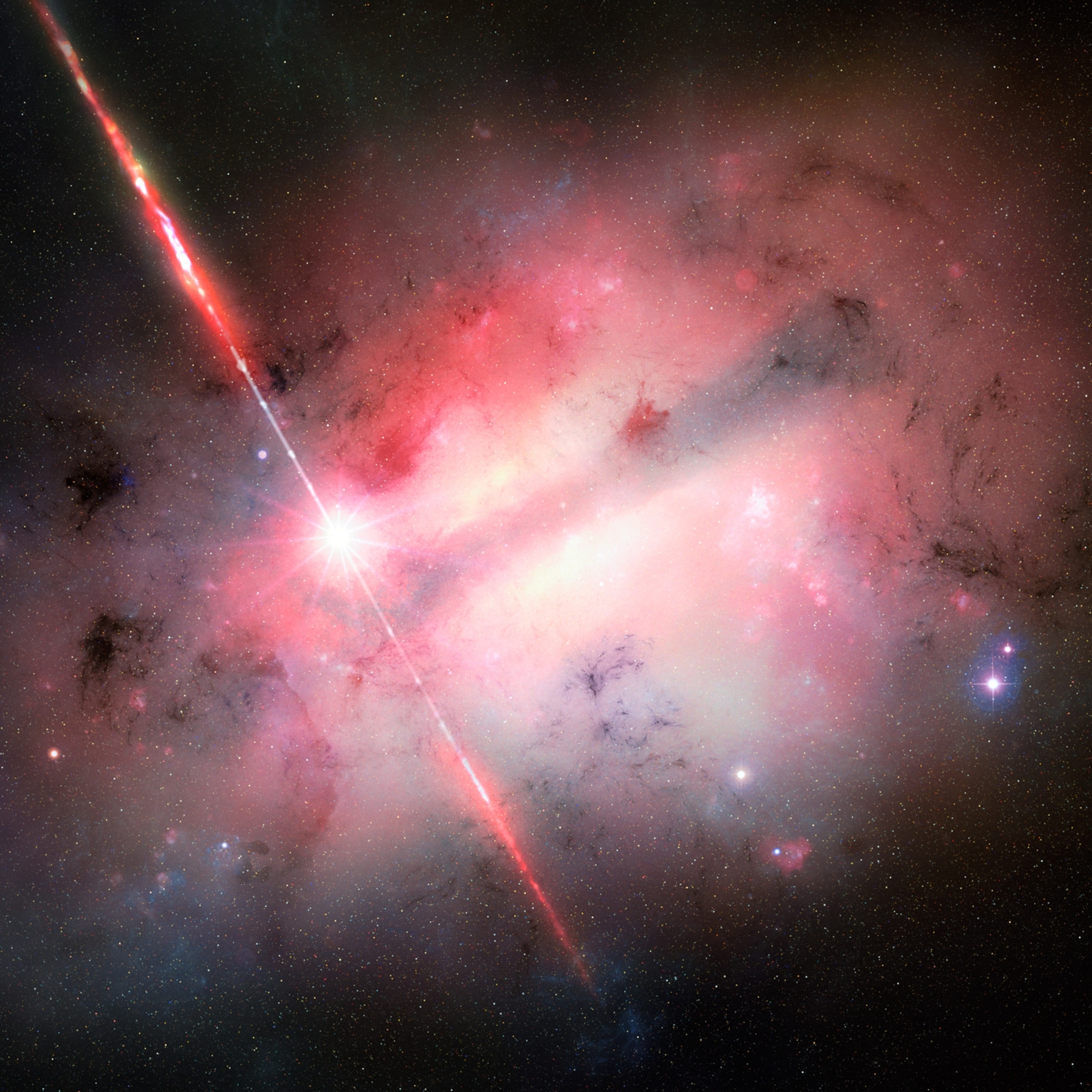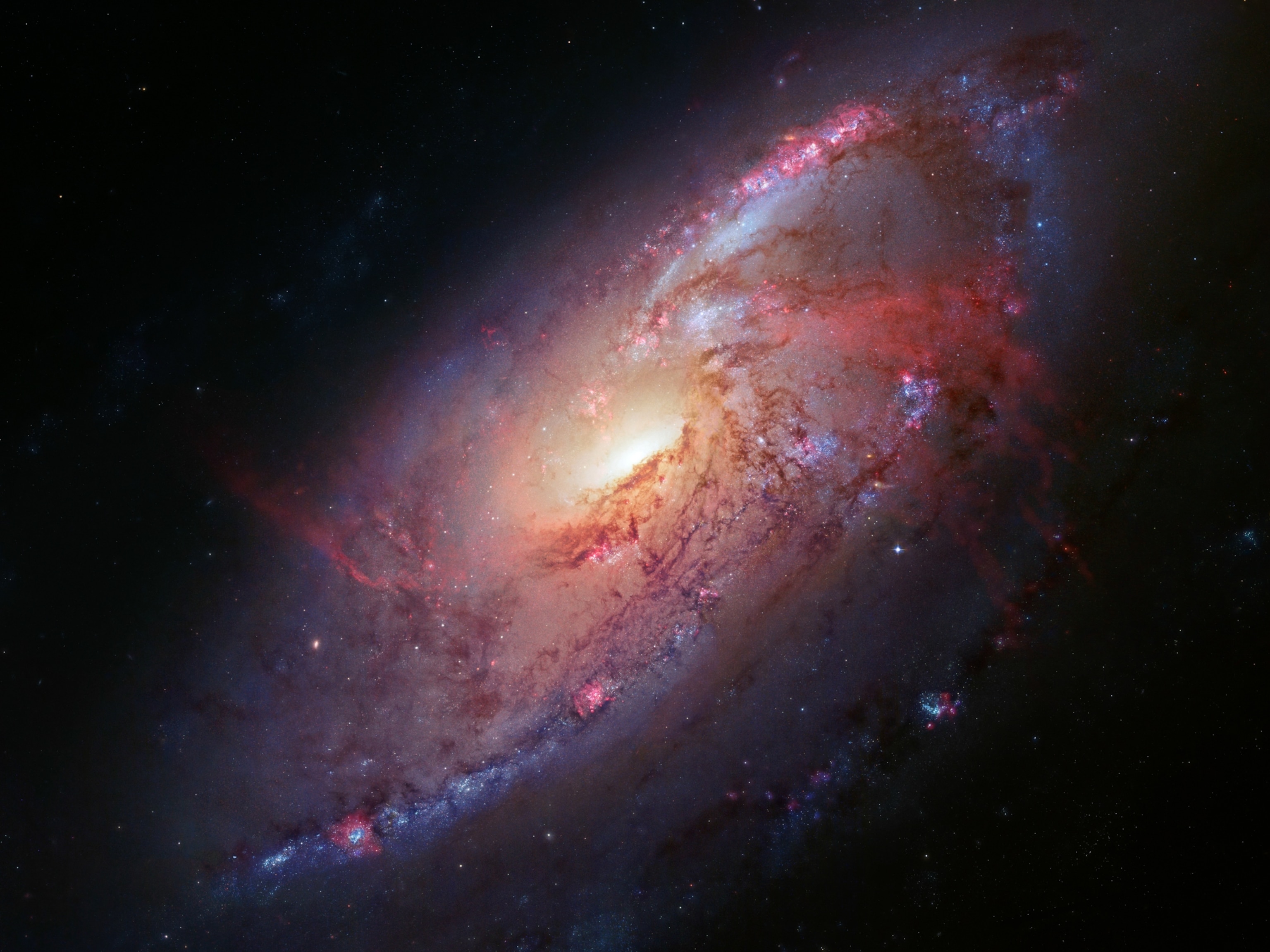
The brightest blast ever seen in space continues to surprise scientists
A once-in-a-civilization burst of gamma rays set off an observing spree by more than 160 telescopes. It’s forcing scientists to revisit long-held theories—and it’s not done yet.
On October 9, 2022, Stephen Lesage was at a Major League Soccer game while visiting Atlanta when his phone buzzed and wouldn’t stop. Once he glanced at it, he realized he had to go.
“I don't care about the score of this game, I’m leaving now,” Lesage recalls telling his friend. An astrophysics graduate student at the University of Alabama in Huntsville, he had just received an alert that the Fermi Gamma-ray Space Telescope had detected something brilliantly bright.
“Right away, we knew it was a big event,” he says. At his hotel room, he hunkered down over his computer, sorted through data until 3 a.m., and helped alert the astrophysics community of a gamma-ray burst (GRB) that scientists would later name the BOAT, or the brightest of all time.
Beyond the superlative, the immense amount of light—so much that the initial burst oversaturated most space telescopes—also means more information about the source. In the 55 years since discovering GRBs, astronomers have developed some ideas about where they come from. The brightest and most energetic of these bursts, like the BOAT, are produced when a massive star collapses into a black hole. In the process, it sends out opposing high-speed jets of particles and light. When these jets are aimed at Earth, we see them flick on with a surge of high-energy electromagnetic radiation known as gamma rays.
Lesage’s colleague Eric Burns, an astrophysicist at Louisiana State University, led the coordinated follow-up search of this event, officially known as GRB 221009A. At least 162 telescopes have contributed to the effort, he says. And these observations are letting scientists peer into the hearts of gamma-ray bursts—the most violent and energetic type of explosion in the universe.
Collapse followed by a blast
When a massive star dies, its center begins to implode. Often its outer layers explode in an outburst called a supernova—a brilliant bright “new star,” as the name means in Latin. Sometimes, if the star held enough mass, the imploding core collapses due to its extreme density into a black hole, and some unknown process can generate two opposing jets of fast-moving particles and light.
Those high-speed jets move quickly through the star’s outer layers of gas. If one is angled toward Earth, then telescopes first see a pulse preceding the full GRB, the so-called prompt signal. And if the GRB is close enough to Earth, and observatories happen to see down the very center—as was the case with the BOAT—then researchers can study the enigmatic process that launches these cosmic jets.
After the high-energy beams escape the star, they slam into less-dense nearby material—the gas and dust floating between stars. That collision releases a shock wave, heating up the nearby gas in an afterglow. This glow is visible across a wide range of light, from radio waves, through visible light, all the way up to gamma rays. Eventually the afterglow fades away over days or years.
Astronomers captured the prompt signal of GRB 221009A with multiple telescopes, and the afterglow across more than 100 other detectors.
The first photons
Last year, on October 9 at 13:17 Coordinated Universal Time, or 9:17 a.m. in U.S. eastern time, a wave of gamma rays flooded the onboard detectors of the Fermi space telescope—the first detection of the event. But researchers didn’t notice right away due to a fluke with NASA’s communication satellites, says Colleen Wilson-Hodge, the principal investigator of Fermi’s gamma-ray burst monitor instrument.
About an hour later, another space telescope, the Neil Gehrels Swift Observatory, came around Earth and spotted the same location on the sky. It detected a bright x-ray afterglow, which alerted the scientific community.
Once Swift announced the detection of the brilliant signal, another Fermi team member, Elisabetta Bissaldi at the Polytechnic University of Bari in Italy, looked at the data and found the telescope had spotted the initial explosion. At this point Lesage got the phone notification and left the soccer game to start analyzing the energy of the burst.
Until well after midnight following the detection, the Fermi and Swift groups worked together to confirm that the unprecedented signal came from an extremely bright GRB. By the next morning, other researchers were preparing additional telescopes to take a look.
Both Fermi and Swift were temporarily overwhelmed by the brightness of the burst, collecting so much light that their detectors were saturated. But China’s GECAM-C space telescope wasn’t blinded, allowing astronomers to measure the energy of the initial gamma-ray blast.
“It's the brightest one ever seen, almost by a factor of 70,” says Burns. This extreme brightness is due to the fact that the GRB was relatively nearby, at some two billion light-years distant, and it also just happened to be an intrinsically bright explosion.
Deciphering the physics
The Fermi telescope sees gamma rays that have energies millions to billions of times the energy of visible light, but these rays of electromagnetic radiation also come in a very high-energy variety. Those have energies thousands or millions of times higher than what Fermi sees—and fortunately the Large High Altitude Air Shower Observatory (LHAASO) in Daocheng County, China, captured signals generated when the highest energy gamma rays of the BOAT disrupted Earth’s atmosphere.
LHAASO collected tens of thousands of photons—an amount unheard of before in gamma-ray astronomy—from a few minutes after the initial blast and into the afterglow. The observatory also collected the highest-energy gamma rays ever from a GRB, so high that some astrophysicists suggest they may point to new physics and hints of unseen, mysterious matter.
According to current theories, these highest-energy photons shouldn’t be able to pass through the universe for two billion years, as seen from GRB 221009A. However, one way to detect these signals is if the very high-energy gamma rays convert into a hypothetical particle of dark matter called an axion, which then travels unimpeded through the universe and converts back once it reaches our galaxy’s magnetic field.
“We don't know if they exist,” says Lara Nava of the National Institute of Astrophysics in Italy, referring to axions. But “it's quite safe to say that there is something unusual or there is some unconventional physics.”
Whatever way the extreme gamma rays traversed the cosmos to get to Earth’s detectors, these observations can help reveal the physics of what’s powering the extraordinary jets of gamma-ray bursts. With previously observed GRBs, the source spews its several-seconds initial blast, then goes quiet very briefly, before the jet-induced shock wave starts plowing through nearby material, making it glow.
Astronomers thought that meant whatever process launched those jets stopped after the first signal. But GRB 221009A didn’t quiet down, which means whatever drives the jets continues for longer than scientists thought.
By comparing the highest-energy gamma rays to the lower-energy varieties, scientists could start to fill in pieces of the puzzle. University of Nevada, Las Vegas, astrophysicist Bing Zhang, who has collaborated with the LHAASO team and worked to develop theories about what drove the burst, says the observations suggest strong magnetic activity is mostly responsible for launching the jets. But there’s a lot more data to get through.
“In terms of understanding GRB physics, we probably will digest this one for many years to come,” Zhang says.
Other evidence also points to magnetic fields dominating the jets. Astronomers using a NASA space observatory called the Imaging X-ray Polarimetry Explorer (IXPE) and the European Space Agency’s Integral satellite studied how x-ray light bounces off surrounding dust, which can tell them about the orientations of the magnetic fields.
Both teams have seen hints the magnetic fields are arranged, or “ordered,” in such a way that indicates they’re funneling energy from the forming black hole into the jets, something that hadn’t been seen in this level of detail before. “This is kind of a big deal,” says physicist Michela Negro of Louisiana State University, who led the IXPE analysis.
Into the afterglow
Following the detection of high-energy signals from the BOAT, astronomers have also searched the source for the glow of the supernova itself. The James Webb Space Telescope (JWST), which sees infrared light that can pierce through gas and dust, is the ideal telescope to look for this glow.
Andrew Levan of Radboud University in the Netherlands and colleagues used JWST to look for signals from this supernova blast. For years, astronomers have debated whether a bright gamma-ray burst requires a bright supernova.
“We know for sure now that the answer to that is no,” says Levan. Either the supernova didn’t exist or was so faint they couldn’t see it in the JWST observations, collected 12 days after the burst. Other observatories that looked at the early afterglow, such as Hawaii’s Panoramic Survey Telescope and Rapid Response System (Pan-STARRS), did see evidence of a faint supernova.
Then the sun got in the way of the observations, and most telescopes couldn’t look toward the source again for months. Another JWST observation from a different group of astronomers in April spotted evidence of the supernova glow beginning to show up. “So maybe actually, the most powerful gamma-ray bursts will have weak supernovae,” says Levan.
The reason for that, he adds, could be that the forming black hole swallows much of the material from the collapsing star—the outer gaseous layers—and coverts that mass into energy to power the jets. In that case, there would be little star matter left to explode as a supernova.
Putting the pieces together
GRB 221009A is now the most-studied gamma-ray burst in history, and researchers have published dozens of research papers about it already. Some of those analyses oppose others. The next step is to piece together how the hundreds of individual observations of this GRB fit together, says University of Oxford astrophysicist Lauren Rhodes, who is studying the blast in both radio and optical light.
Meanwhile, LSU’s Burns is building a shared database of all observations so that astrophysicists can study the bigger picture about how this burst evolved and what powered it. Researchers have wondered for decades what causes these extraordinary eruptions in space, and the BOAT could prove crucial to solving the mystery.
“This is a very amazing event,” says Negro. “We have to explore all the data that we have, and really work together as a community to understand better what's going on.” When she and colleagues wrote a last-minute proposal to observe GRB 221009A with the IXPE telescope, she stated that “this is one-in-a-lifetime event,” and “it's now or never.”
This wasn’t an exaggeration. After comparing the event to the 50-year archive of GRBs, Burns calculated the BOAT was not just a once-in-a-lifetime burst. “It occurs like once in 10,000 years,” he says. “We basically all got insanely lucky.”








